Hydroponic farming, a method of growing plants without soil, has gained significant attention in recent years as a sustainable and efficient alternative to traditional agriculture. This innovative approach offers numerous advantages, but it also comes with its own set of challenges. In this article, we will explore the pros and cons of hydroponic farming, providing a comprehensive overview of its potential impact on the future of agriculture.
Advantages of Hydroponic Farming
Hydroponic farming presents several benefits that make it an attractive option for modern agriculture. These advantages range from environmental sustainability to increased crop yields and resource efficiency.
Resource Efficiency
One of the most significant advantages of hydroponic farming is its efficient use of resources. Traditional farming methods often require large amounts of water and land, which can be scarce in certain regions. Hydroponics, on the other hand, uses up to 90% less water than conventional soil-based farming. This is because the water in hydroponic systems is recirculated, reducing waste and ensuring that plants receive the exact amount of nutrients they need.
Additionally, hydroponic systems can be set up in urban areas or regions with poor soil quality, as they do not rely on soil for plant growth. This allows for the cultivation of crops in places where traditional farming would be impossible or inefficient, thus maximizing the use of available space.
Increased Crop Yields
Hydroponic farming can lead to significantly higher crop yields compared to traditional methods. This is due to the controlled environment in which the plants are grown. Factors such as light, temperature, and nutrient levels can be precisely managed to optimize plant growth. As a result, plants can grow faster and produce more fruit or vegetables per square meter than they would in a conventional setting.
Moreover, hydroponic systems can support year-round production, as they are not subject to seasonal changes or adverse weather conditions. This continuous production capability can help meet the growing demand for food in an increasingly populated world.
Environmental Benefits
Hydroponic farming offers several environmental benefits that make it a more sustainable option compared to traditional agriculture. By reducing the need for large tracts of arable land, hydroponics helps preserve natural ecosystems and biodiversity. Furthermore, the reduced water usage and elimination of soil erosion contribute to the conservation of natural resources.
Another environmental advantage is the reduction in the use of pesticides and herbicides. Since hydroponic systems are typically enclosed and controlled, there is less risk of pest infestations and weed growth. This minimizes the need for chemical interventions, leading to cleaner and safer produce.
Challenges of Hydroponic Farming
Despite its many advantages, hydroponic farming also faces several challenges that must be addressed to ensure its viability and widespread adoption. These challenges include high initial costs, technical complexity, and energy consumption.
High Initial Costs
One of the primary barriers to the adoption of hydroponic farming is the high initial investment required to set up a system. The cost of equipment, such as grow lights, pumps, and nutrient delivery systems, can be prohibitive for small-scale farmers or those with limited financial resources. Additionally, the need for specialized knowledge and training to operate and maintain these systems can further increase the initial costs.
While the long-term savings in water and land use can offset these initial expenses, the upfront costs remain a significant hurdle for many potential adopters.
Technical Complexity
Hydroponic farming requires a certain level of technical expertise to manage the various components of the system effectively. This includes monitoring and adjusting nutrient levels, pH, and environmental conditions to ensure optimal plant growth. For those unfamiliar with these processes, the learning curve can be steep, and mistakes can lead to crop failure.
Furthermore, the reliance on technology means that system malfunctions or power outages can have a significant impact on crop production. This vulnerability necessitates robust backup systems and regular maintenance to ensure consistent operation.
Energy Consumption
While hydroponic farming is more water-efficient than traditional agriculture, it can be more energy-intensive. The need for artificial lighting, climate control, and water circulation systems can result in higher energy consumption, particularly in large-scale operations. This increased energy use can offset some of the environmental benefits of hydroponics, especially if the energy is sourced from non-renewable resources.
To mitigate this issue, many hydroponic farms are exploring the use of renewable energy sources, such as solar or wind power, to reduce their carbon footprint and enhance sustainability.
Conclusion
Hydroponic farming offers a promising alternative to traditional agriculture, with numerous benefits such as resource efficiency, increased crop yields, and environmental sustainability. However, it also presents challenges, including high initial costs, technical complexity, and energy consumption. As technology advances and more research is conducted, it is likely that these challenges will be addressed, making hydroponic farming a more accessible and viable option for farmers worldwide.
Ultimately, the future of hydroponic farming will depend on the ability to balance its advantages with its challenges, ensuring that it can contribute to a more sustainable and food-secure world.



